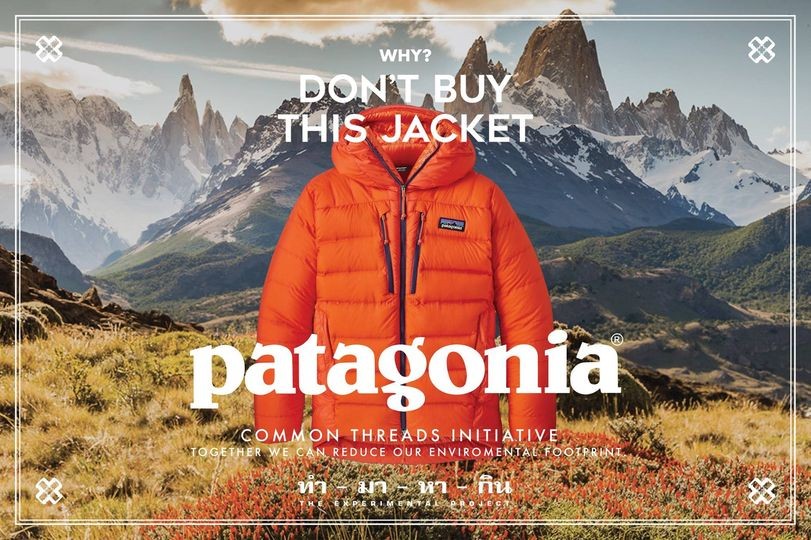The picture depicts an example of an advertisement by a company called Patagonia that promotes eco-friendly or green practices. Patagonia, an outdoor clothing and gear retailer known for its strong commitment to environmental sustainability. Here the company aims to present it’s “Don’t Buy This Jacket” campaign. It conveys an expression of green marketing especially in the context of greenwashing and genuine sustainability efforts.
This advertisement shows a high-quality, durable down jacket designed for outdoor activities. The advertisement is a still-based image, primarily featured in in the New York Times on Black Friday in 2011, as well as other digital platforms.
The ad features a rugged outdoor scene with a close-up image of a Patagonia down jacket hanging. The background showcases a serene natural landscape, emphasizing the jacket’s connection to the environment. Bold text overlays the image with the message: “Don’t Buy This Jacket,” accompanied by Patagonia’s logo and a brief explanation about the environmental impact of consumerism.
The jacket is centrally positioned, drawing immediate attention. The composition is balanced, with the natural landscape occupying the background, creating a harmonious blend between the product and its environmental context. The composition of this picture includes earthy tones dominating the advertisement—greens, browns, and blues—evoking a sense of nature and sustainability. The colours are muted, aligning with Patagonia’s eco-friendly image. The Patagonia jacket is the focal point, highlighted by its prominent placement and detailed depiction. The natural setting reinforces the jacket’s purpose for outdoor use. A natural outdoor environment, possibly a forest or mountain area, indicating the jacket’s use in such settings. A high-resolution and clear, showcasing the texture and quality of the jacket. The image is realistic, avoiding abstract elements to maintain authenticity. The comparison of the product with the pristine environment emphasizes sustainability. The bold “Don’t Buy This Jacket” text serves as a provocative call to action. No people are featured, allowing the product and the environment to take central position. It emphasizes the message about consumerism and environmental impact.
It visually describes a critique of consumerism and an encouragement to reduce unnecessary purchases. By stating “Don’t Buy This Jacket,” Patagonia is urging consumers to consider the environmental cost of their consumption habits.
All pictorial elements contribute to the natural backdrop aligns the product with environmental preservation and the contradictory message challenges consumers to think critically about their purchasing decisions. Also, the simplicity of the design avoids clutter, making the message clear and impactful.
Patagonia aims to create an environment of sustainable consumption by highlighting the environmental impact of producing and buying new products. It encourages customers to invest in durable goods, repair existing items, or consider the necessity of their purchases.
The target audience are the environmentally conscious consumers, outdoor enthusiasts, and individuals who value sustainability. Talking about the effectiveness of this ad, it is highly effective as it directly appeals to the values of its target audience. By taking an unconventional approach, it tells consumers not to buy their product, it reinforces Patagonia’s commitment to sustainability and builds trust with its audience. Patagonia’s established reputation for environmental activism lends credibility to the message. The serene natural imagery evokes a sense of responsibility towards preserving the environment. By using reverse psychology (“Don’t Buy This Jacket”) grabs attention and provokes thought, making the message memorable.
The advertisement touches me because it challenges traditional advertising norms, making it stand out. It inculcates a sense of responsibility and encourages mindful consumption, which can lead to positive behavioural changes in consumers. Patagonia is widely recognized for its environmental advocacy, sustainable practices, and ethical manufacturing. The company is often cited as a leader in corporate responsibility.
The article in Harvard Business Review discusses Patagonia’s innovative approach to sustainability, highlighting their efforts in using recycled materials and promoting product longevity.
The article in Journal of Business Ethics praises Patagonia for integrating environmental responsibility into its core business strategy, setting a benchmark for other companies.
The article in Environmental Research Letters critiques the scalability of Patagonia’s sustainable practices, questioning whether such models can be maintained as the company grows.
The article in Journal of Consumer Research examines the potential for greenwashing, analysing whether Patagonia’s marketing sometimes overstates their environmental impact.
Moreover in response to consumer and environmental critiques by enhancing its sustainability initiatives Patagonia launched the Worn Wear program to encourage repairing and reusing clothing, and they have increased transparency in their supply chain. These actions demonstrate a genuine commitment to sustainability rather than superficial greenwashing.
In conclusion, Patagonia’s “Don’t Buy This Jacket” advertisement is a powerful example of eco-friendly marketing that effectively communicates a message of sustainable consumption. By leveraging strong visual elements, a provocative message, and aligning with their brand’s ethical practices, Patagonia successfully engages its target audience and promotes environmental responsibility. This advertisement not only highlights the company’s commitment to sustainability but also challenges consumers to rethink their purchasing habits, making it a compelling subject for your critical analysis.
References
Bibliography
Uri Neren. “Patagonia’s Innovative Approach to Sustainability.” Harvard Business Review, 2020.
Journal of Business Ethics. “Corporate Responsibility and Sustainable Practices: The Case of Patagonia.” Journal of Business Ethics 159, no. 4 (2019): 1011–1025.
Environmental Research Letters. “Assessing the Scalability of Sustainable Business Models: Patagonia’s Approach.” Environmental Research Letters, 2021.
Nguyen T. Pham, Paul G. Barretta. “Green Marketing or Greenwashing? Analysing Patagonia’s Sustainability Claims.” Journal of Consumer Research 49, no. 3 (2022): 567–583.


Nathan.C
I like the way you provide a thorough description and analysis of Patagonia’s “Don’t Buy This Jacket” advertisement, however, I think the critique of greenwashing could have been more developed. While you effectively describe the ad’s visuals and purpose, you did primarily focus on the positive aspects of the advertisement. That being Patagonia’s message of sustainability, the environmental responsibility it encourages, and the effectiveness of the campaign. Your focus on the use of reverse psychology is also strong. By pointing out how Patagonia tells consumers not to buy their product, you highlight the cleverness of the ad’s approach and its ability to grab attention through an unconventional tactic. Additionally, your recognition of Patagonia’s established reputation for environmental advocacy adds an important layer of context to your analysis. You’ve linked the advertisement to Patagonia’s broader brand image, suggesting that the ad’s credibility is enhanced by the company’s long-standing commitment to sustainability.
That said, you could strengthen these points by exploring how effective these strategies are in addressing or potentially contradicting issues like consumerism or greenwashing. While you mention Patagonia’s genuine sustainability efforts, you do not critically examine whether the company may be overstating its environmental impact or using the ad as a marketing tool to boost sales. For instance, the ad encourages people not to buy a jacket but still advertises Patagonia’s product, which could be seen as contradictory or manipulative.
The use of scholarly sources is good, referencing articles from Harvard Business Review and Journal of Business Ethics. However, the critique in Environmental Research Letters questioning the scalability of Patagonia’s sustainability practices could have been explored more deeply. Your analysis could have also benefited from a more balanced view of greenwashing by discussing whether Patagonia’s marketing strategy may unintentionally contribute to overconsumption.